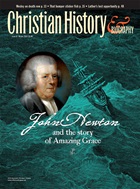Newton's "Amazing Grace" never enthralled his country as it has ours. The British apathy is captured in John Julian's classic Dictionary of Hymnology (1892), where he says the famous hymn is "far from being a good example of Newton's work." This indifference might have been because the tune that now seems so essential to the attractiveness and memorability of "Amazing Grace" wasn't yet widely used, or because the British usually preferred a more restrained and unemotional type of religion. Whatever the reason, the words of "Amazing Grace" articulately express American Christianity's emphasis on the conversion experience and simultaneously describe America's cultural and historical journey.
Revival's "camp classics"
At the time of Newton's death, the dramatic religious revival later known as the Second Great Awakening was in progress. Initially centered on the border of Tennessee and Kentucky, it was characterized by a huge emotional outpouring of dancing, wailing, jumping, laughing, and collapsing. The new style of "camp meeting" revival demanded a new style of worship. The songs had to be memorable because out in the field, in the half light, there could be no hymnals.
As this religious revolution intensified, a parallel musical revolution was under way. Ordinary working people liked to sing, yet almost none of them could read music, and most churches didn't have musical instruments. This meant that congregations were entirely dependent on song leaders to strike up tunes and carry them.
To make music more accessible, a different notation had been developed that was relatively easy to learn. This was the "shape-note system," so called because the key to recognition was the shape of the note rather than its position. Peripatetic singing instructors would visit a town for two or three weeks, setting up evening classes in available spaces. The natural outcome was a surge of interest in communal singing and then a growing body of ordinary Americans who had mastered the rudiments of music.
No, Newton didn't write the tune
Shape-note singers used tune books rather than hymnals. Hymnals were pocket-sized books with texts only. Tune books were large, oblong books with hard covers, often more than 400 pages long. They included both music and text and were introduced by an extended essay on the rudiments of music. It was in one such tune book, Columbian Harmony (1829), that "New Britain," the music we now use with "Amazing Grace," was first published.
The marriage with Newton's words took place three years later, in William Walker's celebrated tune book The Southern Harmony, an event that makes Walker second only to Newton himself in the story of "Amazing Grace." Today it is hard to hear the tune without imagining the words, and hard to read the words without hearing the tune, yet until Walker saw their compatibility both elements of the song were leading independent lives.
Until this time "Amazing Grace" had been sung to a variety of tunes. When Walker put it with "New Britain" he displayed real genius, because not only did the words fit snugly into the required musical space but the music enhanced the meaning. The music behind "amazing" had a sense of awe to it. The music behind "grace" sounded graceful. There was a rise at the point of confession, as though the author was stepping out into the open and making a bold declaration, but a corresponding fall when admitting his blindness.
The Southern Harmony proved enormously successful. It sold an estimated 600,000 copies in a country where the population in 1850 was only just more than 23 million. The book's success played a vital role in establishing "Amazing Grace" in America. The words corresponded to the American experience in a unique way, not only by delineating the archetypal evangelical conversion but by articulating the groans of a people who frequently had to struggle with poverty and sickness. No other nation was made up of so many pioneers and immediate descendants of pioneers. "Dangers, toils, and snares" had particular resonance for those who'd suffered for their adventure, as did the promise that grace would "lead me home."
The country ditty, citified
During the Civil War, hymnals such as Hymns for the Camp (1862) and The Soldier's Hymn Book (1864), both of which included "Amazing Grace," were distributed to troops. The prospect of death created a mood of seriousness, and there was a dramatic increase in Bible studies and informal church services among the new recruits.
The song retained its popularity in the rural South, the natural home of The Southern Harmony, and then spread into the major cities of the North. If it hadn't been taken up by northern city dwellers, the tastemakers of postbellum America, it could well have been regarded as merely a quaint example of what country folk used to sing before the war.
The song's spread to the North was helped by a new style of urban evangelism that featured vocal music. The best-known practitioners were preacher Dwight L. Moody and his song leader Ira Sankey. Since Sankey included "Amazing Grace" in his publications, the song was introduced to a wider audience and couched in a fresh context.
The slave-trader's song reaches the slaves' hearts
Away from the gaze of professional musicians, "Amazing Grace" also took root among slaves. Its growth as a white song had been clearly recorded in the books and hymnals, but not so its parallel development as a black song. Enforced illiteracy prevented slaves and their immediate descendants from keeping a detailed record of cultural changes. The slaves took warmly to eighteenth-century English hymns, and it's easy to see why "Amazing Grace" would emerge as the most loved. It appeared to tell their story. The very fact of their survival proved God had looked after them so far. They might be downtrodden, but there were still victories to be gained, temptations to resist, diseases to be freed from. Like Paul and Silas imprisoned in Philippi, they were able to sing in their chains.
Slaves first learned "Amazing Grace" at the churches of their white masters and mistresses, where they were taken to ensure that they learned how to be worthy, obedient servants; yet contained within its words was the secret of inner release. From the lyrics, the slaves gained assurance that it was possible to be physically enslaved and yet spiritually free. It was possible to be materially impoverished and yet have an overflowing account of righteousness in heaven.
The "Amazing Grace" rendition sung in black churches varied greatly. Men known as "shouting preachers" told folksy tales and then spontaneously broke into a song supported by a small congregation. "Amazing Grace" was one of the few songs to live through this transition from spirituals and "shouting preachers" to the blues- and jazz-inspired gospel music that entered its golden age during the 1940s and 1950s. All the great gospel singers recorded "Amazing Grace," which reminded them of family roots and the fundamentals of their faith.
Newton the hippie?
During folk music's hippie heyday, "Amazing Grace" began to assume powerful meaning even within a secular context. On the opening night of Woodstock in August 1969, Arlo Guthrie performed only three songs, one of which was "Amazing Grace." The song became a highlight of his live show as he broke between stanzas to recount a fanciful version of Newton's life story. To Guthrie, Newton represented the best the 1960s counterculture could offer.
"I used to think, what's this 'saved a wretch like me'? Was it the same old Puritanical 'we hate everything including ourselves' stuff?" Guthrie said. "In Newton's case, he really was a wretched character and he really did feel he had been saved. In his case it wasn't keeping the world safe from weirdos and he ends up being a countercultural figure. He went against the grain of the times."
The watershed event for the popularization of "Amazing Grace" was the a cappella single released by Judy Collins in December 1970, which climbed into the best-seller charts in both Britain and America early in 1971. The timing was right for a hit. The war in Vietnam was dragging on as Americans struggled to come to grips with the My Lai massacre. Charles Manson and his hippie acolytes were appearing before a judge on murder charges. It seemed that both the American Dream and the hippie dream had ended up in the same place. There was a widespread yearning for less complicated times, for the days before napalm and LSD, for values that had stood the test of time. "Amazing Grace" provided an appropriate salve.
A uniting icon
For a hymn written by an eighteenth-century British Calvinist, "Amazing Grace" is remarkably transcendent. Its use in the wake of the terrorist attacks on New York and Washington illustrated its power to unite Americans and those worldwide who felt sympathy for America. Somehow "Amazing Grace" could embrace core American values without ever sounding triumphalist or jingoistic. It could be sung by young and old, Republican and Democrat, Southern Baptist and Roman Catholic, African American and Native American, military officer and anti-capitalist campaigner.
How sweet the sound, indeed.
This article is adapted from Steve Turner, Amazing Grace: The Story of America's Most Beloved Song. Copyright © 2003. Published by arrangement with HarperCollins Publishers.
Copyright © 2004 by the author or Christianity Today/Christian History & Biography magazine.
Click here for reprint information on Christian History & Biography.

Support Our Work
Subscribe to CT for less than $4.25/month




























